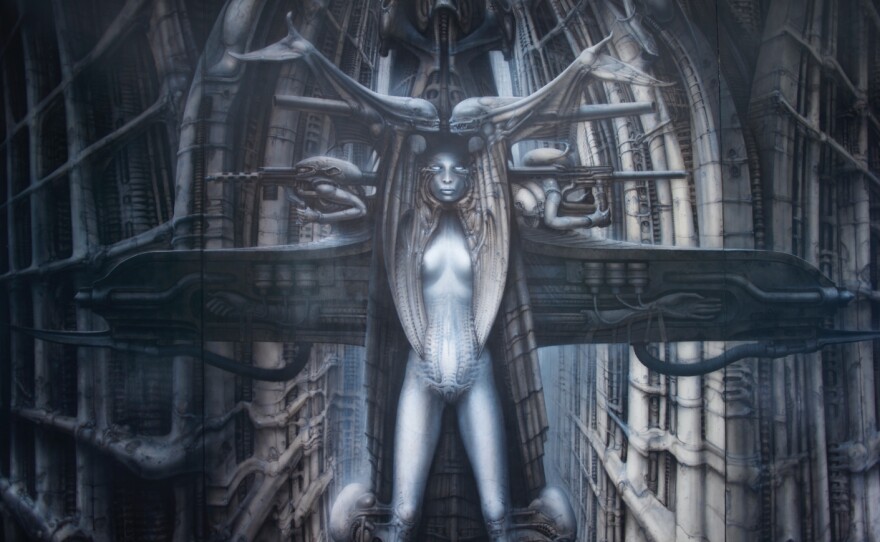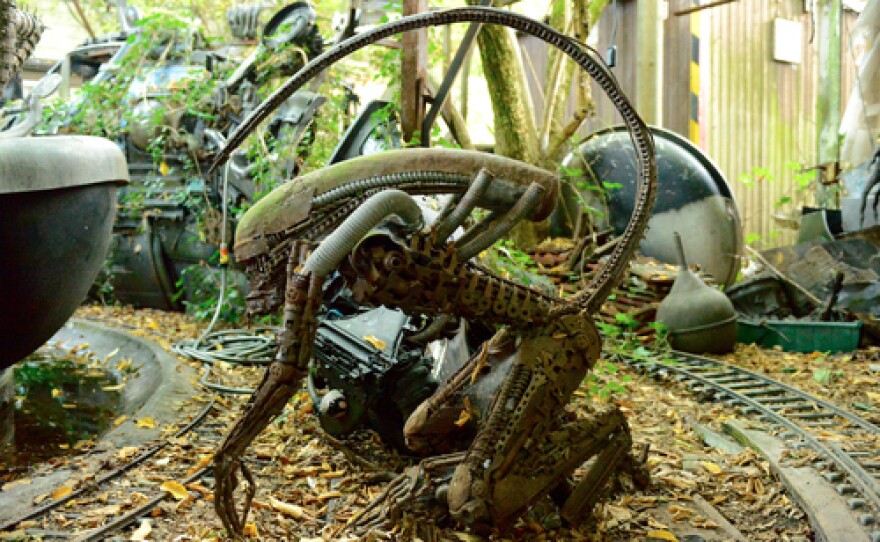ANCHOR INTRO: Swiss surrealist painter H. R. Giger [pronounced GHEE-GUR] is probably best known for designing the creature in Alien. KPBS arts reporter Beth Accomando says the new documentary, Dark Star: H. R. Giger’s World, provides insights into his dark genius. Dark Star begins by taking us through an overgrown garden to the front of H.R. Giger’s house. The door creaks open and we’re met by the disturbing yet mesmerizing women of Giger’s paintings. Author Stanislav Grof calls Giger’s art “biomechanoid.” STANISLAV GROF: He’s mixing machines and human anatomy. It’s a very masterful morphing. So… we’re playing with things like genetic engineering where we don’t have a clue what it’s going to do…and for some reason he decided to become the artistic reporter about what the darkness in us is. Some people run from that darkness, but Giger embraced it. He explains that at the age of six his father gave him a human skull. It scared him to be able to hold death in his hands so he put a string on the skull and pulled it along the street like a reluctant dog in order to conquer his fears. And that’s what Giger’s art does: it looks defiantly into the darkness until it finds a glimmer of light. Belinda Sallin’s documentary brings us into Giger’s world as if we’re the crew of the Nostromo in Alien exploring a mysterious planet. Giger’s Zurich home is a dark labyrinth full of nooks and crannies and cluttered with paintings, sculptures, books and the occasional skull. We’re asked to observe quietly and then draw our own conclusions about this reclusive visionary and his strange, beautiful art. Beth Accomando, KPBS News.
Swiss surrealist painter H. R. Giger is probably best known for designing the creature in "Alien." The new documentary, "Dark Star: H. R. Giger’s World" (opening May 22 for a one-week run at Landmark's Ken Cinema) provides insights into his dark genius.
"Dark Star" begins by taking us through an overgrown garden to the front of H.R. Giger’s house. The door creaks open and we’re met by the disturbing yet mesmerizing women of Giger’s paintings.
In the documentary, author and psychiatrist Stanislav Grof describes Giger's art as "biomechanoid. He’s mixing machines and human anatomy. It’s a very masterful morphing. So we’re playing with things like genetic engineering where we don’t have a clue what it’s going to do and for some reason he decided to become the artistic reporter about what the darkness in us is."
Some people run from that darkness, but Giger embraced it.
He explains that at the age of six his father gave him a human skull. It scared him to be able to hold death in his hands so he put a string on the skull and pulled it along the street like a reluctant dog in order to conquer his fears. And that’s what Giger’s art does: it looks defiantly into the darkness until it finds a glimmer of light.

Belinda Sallin’s documentary brings us into Giger’s world as if we’re the crew of the Nostromo in "Alien" exploring a mysterious planet. Giger’s Zurich home is a dark labyrinth full of nooks and crannies and cluttered with paintings, sculptures, books, and the occasional skull. We’re asked to observe quietly and then draw our own conclusions about this reclusive visionary and his strange, beautiful art.

Giger died shortly after the documentary was shot, which was just over a year ago. He died from injuries sustained after falling down stairs at his home.
Giger looks to be in bad health in the film and after seeing the clutter piled high in his house, it's easy to conceive how he might have fallen. But what's a little creepy is that the final image of the film is Giger unsteadily placing a hand on the rail for the stairs leading down to his basement and beginning his descent.

"Dark Star: H. R. Giger's World" is unrated and in German with English subtitles. The Giger Museum is located in Gruyères, Switzerland.






